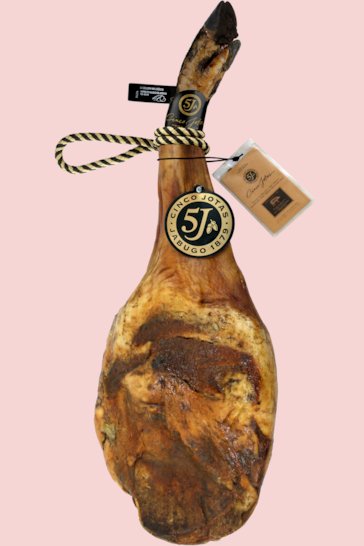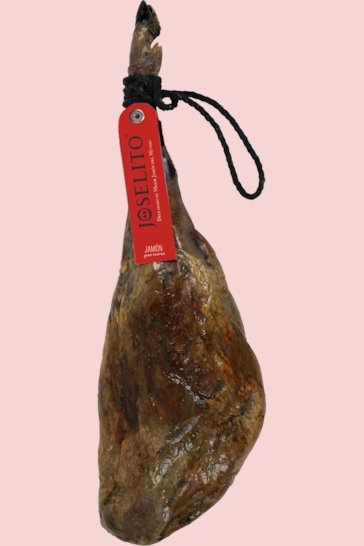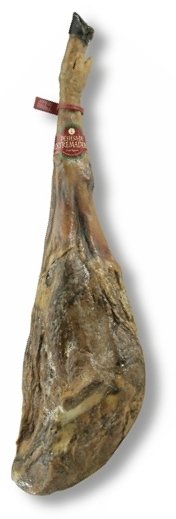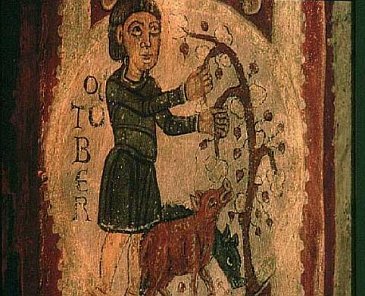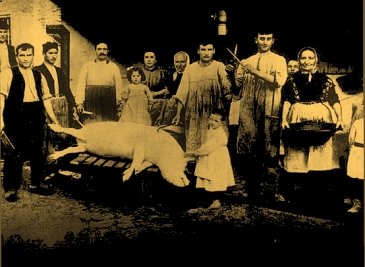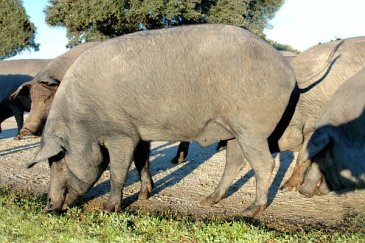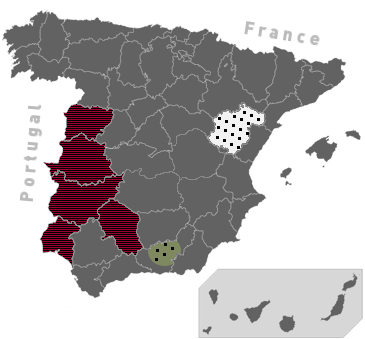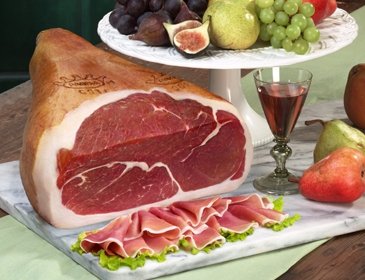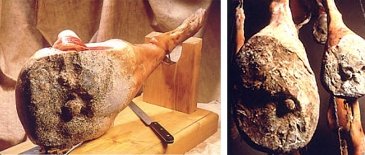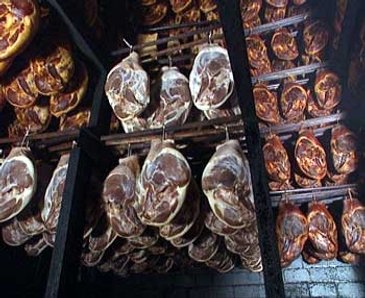UK deliveries: 2-5 days, all customs expenses (~£21) are charged in advance (no extra payment upon receival)
Cured Spanish jamon, either Serrano or Iberico, is made in the artisanal tradition. It is tasty and its nutritional properties make it ideal for a healthy, balanced diet.
Today Spain is the world's leading producer and consumer of ham. Some 38.5 million hams and shoulders are processed each year, and every Spaniard eats nearly 5 kg of ham a year - twice as much as in Italy, second among the consuming countries.
Bone-in, Boneless & Sliced
Bone-in, Boneless & Sliced
Jamones are made from the hind legs of pigs. They are left raw, salted, washed after a few days and cured naturally for months or years.
The smaller forelegs go through the same process, and the end result is called the paleta, or shoulder cut.
There are several types of jamon, depending on the breed of pig, how the pigs are fed and where the jamones are produced.
| Rank | Product | Description | Price Range |
|---|---|---|---|
| 1 | Jamones from Iberian pigs (100% purebred in the case of pata negra), raised exclusively on a diet of acorns and grass on the open range during the montanera. | £48 to £74/kg (jamon) £26 to £39/kg (paleta) |
|
| 2 | Jamones from Iberian pigs, raised on a diet of grass and compound feed on the open range | £26 to £35/kg (jamon) £18 to £22/kg (paleta) |
|
| 3 | Jamones from Iberian pigs (usually cross-bred), raised on compound feed on farms | £18 to £26/kg (jamon) £16 to £18/kg (paleta) |
|
| 4 | Trevélez jamon Gran Serrano jamon |
Jamones from white or Duroc pigs, raised on compound feed on farms (stabled), cured for more than one year at high altitudes in dry climates such as Teruel and Sierra Nevada (Granada province) | £11 to £22/kg (jamon) £7 to £11/kg (paleta) |
| 5 | Oro (gold) Serrano jamon Plata (silver) Serrano jamon |
Jamones from white pigs, raised on compound feed on farms, cured less than 14 months anywhere in Spain | £11 to £13/kg (jamon) £5 to £8/kg (paleta) |
| 6 | Cured jamon |
Jamones from white pigs, raised on compound feed on farms (usually outside of Spain) and cured for less than 8 months | £4 to £9/kg (jamon) £4 to £4/kg (paleta) |
The Greek historian Strabo (1st century B.C.) wrote in book III of his Geography (devoted to Iberia) that the Carretanians, a people of Iberian stock who inhabited the western Pyrenees, made excellent jamones, comparable to those of Cantabria, which afforded them considerable revenues.
In Roman times, cooks known as vicarius supra cenas specialised in making jamones reserved for the elite, especially the renowned jamones of Pomeipolis (today, Pamplona).
Legend has it that jamon had its origin in a pig that fell into a very salty stream and drowned. A group of shepherds pulled the pig from the water, roasted it and discovered it had a pleasant flavour, especially the hind leg. They later discovered that salting the jamon made it keep much longer without losing its flavour, and they gradually perfected the technique until they achieved one of the best cured jamones in the world.
You can find out more about the history of jamon in the following article (in Spanish): El jamón en la gastronomía española (by Antonio Gázquez).
Curing jamones is apparently a simple process. All you need is salt, air and time.
Today the entire process - from slaughter and cutting to curing in the ageing room - takes place in clean, modern, high-tech facilities, ensuring continuous production, uniform quality and appropriate environmental conditions at all times.
The process starts in conditions of low temperature and high humidity, and gradually the temperature is raised and the humidity lowered. It is a natural, spontaneous, ongoing transformation.
After butchering, cutting and shaping (removal of part of the fat, skin and muscle on the outer side of the cut), the jamones go through the following stages of processing:
For more information, see our page on Iberico jamon production.
Modern facilities are not at odds with artisanal processing. To the contrary! The best jamones are processed and controlled one by one.
The end product is very different if, for example, the cuts are salted one by one or if they are placed in a row and salt is thrown over them by a wheel loader. It is very important to use the right amount of salt according to the cut's weight and shape and make sure it is evenly covered. This personalised care is essential in all stages of processing. The big differences in jamon prices are largely due to the care they get in processing.
Until a few years ago nearly all families living in the country had one or two pigs, which they butchered in winter (December or January). The matanza, or traditional pig slaughter, was a festive occasion when many of the perishable parts of the pig were eaten: blood, ribs, snout, etc.).
Families of more modest means used jamones as a means of payment and consumed the various types of sausages (chorizo, salchichón) and other products that could be preserved by marinating, such as pork rind and loin.
Types of jamon are distinguished by three characteristics:
This is one of the most distinctive factors of jamones. The meat and, especially, the way the fat is distributed clearly distinguish a pig's breed.
The meat of pigs belonging to white breeds is much leaner and the fat is on the outside. The jamones known as Jamones Serranos come from these hogs. These cuts are uniform, with reddish meat, white or slightly yellowish fat; they are slightly salty and characterised by a mild aroma.
The meat from pigs of the Iberico breed, is criss-crossed with thin streaks of yellowish marbling fat. This gives it a glossier appearance and helps slow down the curing process, resulting in more complex, powerful aromas. The jamones from these pigs are known as Jamon Iberico. They are characterised by ivory-coloured fat, glossy meat ranging from deep red to purplish red and generous amounts of marbling fat. They are very flavourful, with intense, persistent aromas, faintly salty - almost sweet - and impart notes of curing, burnt sugar, nuts and the ageing room.
Iberico jamon is also popularly known as Jamon Pata Negra (black hoof ham) because the skin and hoof of an Iberian hog are usually black. But this is not an official designation as there are varieties of Iberian pigs that are not black and there are also non-Iberian pigs with black or very dark hides.
White pigs, Iberian pigs and cross-breeds are all reared in Spain. The main breeds for each type are:
White pigs:
Iberico pigs:
Crossbreeds:
Hams from Mangalica pigs are also made in Spain. This is an autochthonous Hungarian breed that is a distant relative of the Iberian pig. The Mangalica has certain peculiarities: Its hair curls in spring, making it look somewhat like a sheep, and it has the highest percentage of fat of all pigs. This makes its hams and loins mature very slowly and, consequently, the aromas are richer. The Mangalica breed was in danger of becoming extinct for many years, but in 1990 a company in Segovia managed to acquire 90 breeding females. Production is very limited.
This is the second most important factor. While white pigs usually eat compound feed made of cereals, among Iberian hogs we find a wide variety of diets, which are the basis for the Iberico jamon grades (they do not apply to Serrano hams):
Jamones are made throughout the country, especially in mountainous areas with mild, dry climates in summer and cold winters, ideal for curing. It is the mountains that give Spanish cured jamones their name. Serrano means "from the sierra", a Spanish word used to describe a mountain range.
But there are differences or nuances in production, depending on areas and producers.
The Iberico ham designation (Jamon Iberico), according to recent legislation, can be used only in regions where the pasturelands described above are found: in the west and southwest of Spain.
Each of these areas has a Designation of Origin with a regulatory board, although there are also producers not associated with it.
Quality does not depend on the area where the Iberico jamones are made; it is guaranteed in all of them. As in the case of wine, the jamones coming from each production area have different sensory characteristics due to climate and autochthonous bacterial flora. The best way to find a favourite is to try jamones from all the different areas.
Serrano jamon is not limited to particular areas, although there are minimum quality requirements established by the European Union for jamones to bear this designation (registered under the European Union Traditional Speciality Guaranteed (TSG) regulation since 1999). The different official Serrano jamon grades are:
The quality of Serrano jamones varies widely, and is reflected in the price.
There are three areas with their own grading seals that also process jamones from white pigs: Teruel (region of Aragon), Trévelez (Granada province, Andalusia) and Serón (Almería province, Andalusia). These jamones are of the highest quality on the peninsula for white pigs and are among the most popular.
Technically, they cannot be called "Serrano ham" jamon serrano, because they each have their own DO.:
The pigs in Teruel are crosses of Landrace and Duroc. The jamones are dried in natural drying areas with controlled ventilation and are matured in a natural environment also. The cuts are taken to drying rooms where they are hung in the optimal humidity and temperature conditions of the natural environment characteristic of a cold, dry area with an average altitude over 800 metres above sea level.
In Trevélez pigs are crosses of Landrace, Large White and Duroc Jersey. Jamons have a rounded shape and are cured between 14 and 20 months. Their particular organoleptic characteristics come from the environment (medium-low area in Sierra Nevada Nature Park) where they are produced. The climate and vegetation result in the growth of a specific type of microbial flora. Curing takes place in facilities located between 1200 and 1900 metres above sea level, a cold area with lots of snow in winter and cool temperatures in summer.
In the jamon curing process the proportion of protein increases and the fat decreases, making it lighter and healthier than the fresh product. The proteins are high-quality and rich in essential amino acids. A 100-gram serving of Serrano or Iberico jamon is the equivalent of 33% of the recommended daily protein intake.
It contains unsaturated fatty acids (similar to those found in olive oil), vitamins B1 and B6, phosphorus, iron, potassium and zinc. And even though it is cured in salt, it contains only a tiny amount.
Jamones from Iberian and white pigs differ considerably, not only in their sensory characteristics but also in their composition. This is due basically to the raw material and the processing.
Iberico jamones have a higher protein content and more vitamin E as a result of their origin (hogs of Iberian breed) and because the pigs are reared in pastureland.
Jamones from white pigs contain more salt because the curing time is shorter.
Energywise, 100 grams of bellota-grade Iberico jamon provide 43 grams of proteins and less than 250 calories, so eating it in moderate amounts will not interfere with low-calorie diets.
Jamon from Iberian pigs fed an acorn diet exclusively is high in monounsaturated fatty acids, which are also found in olive oil. It helps digestion and at the same time increases good cholesterol and reduces bad cholesterol.
Iberico jamon also provides proteins, vitamins B1, B6, B12 and folic acid, which are beneficial for the nervous system and good brain function. It is rich in vitamin E, a powerful antioxidant, and in minerals like copper (essential for bones and cartilage), calcium, iron, zinc, magnesium, phosphorus and selenium. Selenium is linked to processes that retard ageing.
| Olive oil | Bellota-grade Iberico Jamon | White pig Jamon | |
|---|---|---|---|
| Saturated fatty acids Main dietary cause of high LDL levels ("bad cholesterol") |
|||
| Palmitic | 10,70% | 21,04% | 22,00% |
| Stearic | 3,50% | 9,08% | 12,20% |
| Monounsaturated fatty acids Reduce LDLs and enhance HDLs ("good cholesterol") |
|||
| Palmitoleic | 0,60% | 4,50% | 2,80% |
| Oleic | 72,20% | 59,13% | 44,20% |
| Polyunsaturated fatty acids Reduce the risk of coronary heart disease, blood clots and inflammation |
|||
| Linoleic | 10,20% | 5,11% | 8,70% |
| Linolenic | 1,20% | 0,08% | 0,08% |
According to Confecarne and Riber (Registro Informativo del ibérico), the approximate distribution of the production of cured jamones and shoulders by type of product is as follows:
| Cuts 2003 | Cuts 2012 | Cuts 2017 | |
|---|---|---|---|
| Jamon Serrano (White Pig) | 33,222,000 | 32,030,000 | 38,692,000 |
| Paleta Serrana (White Pig) | 3,613,893 | 5,000,000 | 6,040,000 |
| Jamon Iberico | 2,699,287 | 4,518,112 | 5,158,592 |
| Bellota | 439,984 | 812,286 | 1,223,281 |
| Recebo* | 615,437 | 37,456 | 3,198 |
| Cebo de Campo | 18,342 | 770,694 | |
| Cebo | 1,643,866 | 3,650,028 | 3,161,419 |
| Paleta Iberica | 1,993,320 | 4,385,040 | 5,658,883 |
| Bellota | 370,758 | 751,063 | 1,188,174 |
| Recebo* | 448,497 | 31,159 | 95 |
| Cebo de Campo | 14,411 | 876,240 | |
| Cebo | 1,174,065 | 3,588,407 | 3,594,374 |
| Total | 41,527,500 | 45,933,152 | 55,549,475 |
* The Recebo grade was eliminated by the 2014 law. It covered jamones from pigs fattened in woodlands eating acorns and compound feed supplement.
Cured hams are a product typical of southeastern Europe (Spain, Portugal, France and Italy) and are rarely found on other continents. Nevertheless, in spite of this concentrated production in a very specific area, processing and raw materials are so different that the end products have little in common.
Spanish jamon usually has less moisture because of its lengthy curing process, plus a more consistent texture and more intense flavour (especially jamones from acorn-fed Iberian pigs).
The best-known cured hams from other countries are:
The culatello is the end of the ham (the tastiest part). It is often sold separately and is much more expensive.
These hams are usually sold without the hoof and the skin slightly cut at the tip.
